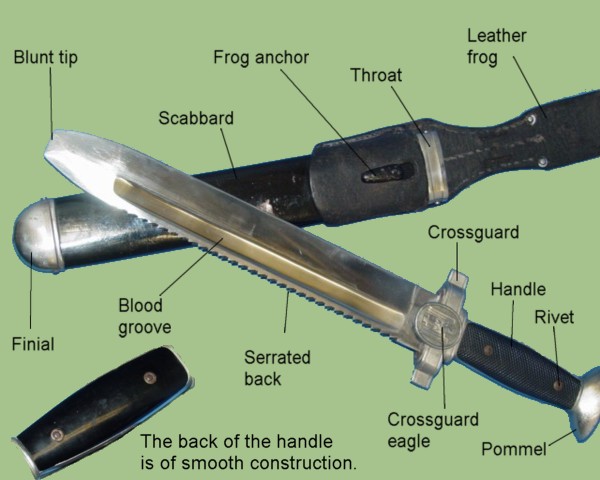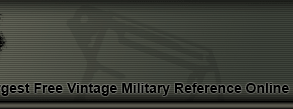WWII German Red Cross Daggers -
The German Red Cross was recognized in accordance with the agreement of Geneva dated July 27th 1929. The first formal uniforms were established on August 6th 1935. The leader and subordinate daggers were introduced in 1938.
The anatomical view of the Red Cross dagger follows:

RED CROSS SUBORDINATE HEWER
The rules from the Geneva convention brought restrictions to the Red Cross side arms unlike any applied to other
branches who used daggers as part of their uniforms. The Geneva rules indicated that members of the Red Cross
of any country engaged infighting could not wear any weapons while performing their humanitarian duties. The
idea was that not carrying a weapon would afford a certain level of protection to red Cross personnel during
combat operations. They should not be fired upon by enemy forces.
This is the Red Cross Subordinate Hewer .

The blade of the red cross subordinate hewer is one of the most interesting aspects of the dagger. In terms of
dagger baldes it is massive and menacing looking. It is of chromed finish. It has a double-tooth serrated back
that covers approximately 85 percent of the length of the blade. The tip ends abruptly in a straight cut, which
was done this way in order to comply with the requirements of the Geneva convention. if the tip was pointed
then it would be considered a weapon.
This
dagger is one of the few that had a double purpose. It was worn at special events such as dinner parties, weddings,
parades, etc. but it was also carried into the battlefield where the serrated edge proved very useful to
remove casts, construct splints, removing limbs, etc.

The pommel of the Red Cross Hewer was a solid piece of metal of silver color. The handkles were made of plastic.
The front handle was of a evry tight checkered pattern while the revese was of smooth texture. The crossguard
was of silver color as well. fairly thick construction. An eagle is placed inside an oval in the center fo the
crossguard.
The scabbard is of metal construction. Smooth black paint. The finial is composed of a round silver metal
piece. A frog anchor is attached near the neck area in the front. The frog was made of leather. It was of
sturdy construction as it had to secure the dagger which was large and heavy. A belt loop is found in the
upper section of the frog.
RED CROSS LEADER DAGGER
The Geneva convention rules also applied to members of the Red Cross leadership. Just like with the
Subordinate Hewer, certain rules had to be observed by the leaders in order to satisfy the convention.
The dagger could only be worn with the dress uniform. It could not be carried into combat situations.
The following is a Red Cross Leader dagger .

The design of the red Cross leader dagger consisted of a silver metal piece for pommel. Of oval shape.
The pommel housed a multi-point head screw which held all the dagger components in place. The handle
was orange in color. It was made of cellulite, which was an early plastic. Swirled design. There was
no wire wrapping among the handle grooves.
The scabbard was of metal construction. It had four panels of pebbling. The finial was built in as
opposed to being a separate fitting.

The blade of the leader's dagger was of stiletto style. Double edge with a sharp point. The
crossguard eagle oval is so pronounced that it covers a portion of the base of the blade,
 |
The crossguard is constructed of a single piece with several liens that make it appear as if though it is
of multi-piece construction.
The pebbling pattern found in front and reverse pannels of the scabbard are very visible in this photograph.
They were executed very tightly.
Simulated bands are applied to the throat and mid-point of the scabbard. These are the points where the hanger
was connected with the use of clips.
The hanger suspension opening found in the scabbard of the Red Cross leader's dagger is of rectangular
shape.
This is the only characteristic that distinguishes leader's daggers from this branch
compared to the social welfare branch of the Red Cross.
|
RED CROSS LEADER DAGGER - SOCIAL WELFARE BRANCH
The Red Cross had a Social Welfare branch. A leader dagger was issued to members of this organization.
The main function of this branch was to deal with the civilian population inside of Germany. It provided
housing and food to destitute individuals. This branch was fairly small when compared to the regular
Red Cross.

The Geneva convention also applied to members of this organization. Even though they were not exposed to combat
situations they remained an active part of the Red Cross. The dagger was to be worn with the dress uniform only.
The design of the dagger was almost identical to its counterpart, the regular Red Cross leader. The pommel was
composed of a silver metal piece with a multi-point head screw visible from the top. The handle was orange and
made of cellulite. It was of swirled pattern but did not have any wire wrapping.
The crossguard is silver in color. It has an oval shape with an eagle in its center. The reverse side of the
pommel retains the same oval shape but it is blank. A silver portapee is tied to the handle of this example.
The scabbard is of metal construction.
 |
The blade for the Social welfare leader's dagger was identical to the one used with the regular Red
Cross. Of stilleto type. Double edge. The crossguard eagle is large enough to cover a percentage of the
base of the blade. No motto or organizational logo was ever applied to the blade.
The picture here shows a clear view of the hanger bands found on the scabbard. The pebbling found in the
body panels was well defined and applied in a very tight pattern.
A closeup of the portapee is also shown here. The rope was made of silver strands and looped around the
pommel and the base of the handle.
The hanger suspension opening found in the scabbard of the Red Cross leader's dagger for the social welfare
branch is of round shape.
This is the only characteristic that distinguishes leader's daggers from this branch
compared to the regular Red Cross.
|
RED CROSS DAGGER MANUFACTURERS
The vast majority of the Red Cross daggers are not manufacturer marked on the blade, they were marked on
the tang.
The following is a list of some of the companies that manufactured the DRK daggers during WWII.
| Count |
Number |
Company |
Description |
Logo |
Comments |
| 1 |
1 |
Robert Klaas |
Storks stamped |
n/a |
Manufactured the subordinate hewer |
| 2 |
|
Robert Klaas |
Storks and name |
n/a |
Manufactured the subordinate hewer |
| 3 |
|
Robert Klaas |
Storks and name on curve around |
n/a |
Manufactured the subordinate hewer |
| 4 |
2 |
P D Luneschloss |
Sword piercing helmet in oval |
n/a |
Manufactured the subordinate hewer |
This information is brought to you courtesy of MilitaryItems.com. The premiere provider of military
collectibles to musuems, educational institutions and the general enthusiast.
|







